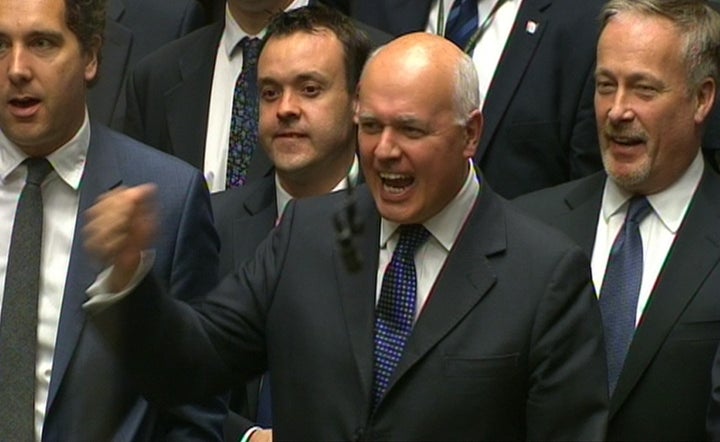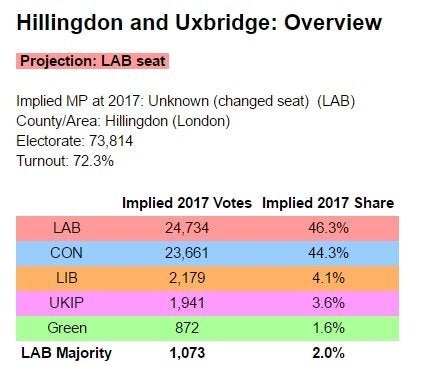Lead Brexiteers Boris Johnson and Iain Duncan Smith are set to lose their Commons seats at the next election thanks to the impact of the “Corbyn surge” on Westminster boundary changes, a new study suggests.
The review of all Parliamentary seats in the wake of the 2017 election projects that the Foreign Secretary will be ousted by Labour in the new constituency of Hillingdon and Uxbridge.
Former Work and Pensions Secretary Duncan Smith is also on course to be defeated by Corbyn’s party in the newly created Chingford and Woodford Green seat, according to elections analyst Martin Baxter of the Electoral Calculus website.
But there is better news overall for the Tories as the boundary review would edge them closer to a majority government. One estimate suggests they would fall three seats short, compared to eight seats short now. Another points to the actually squeaking a majority.

Johnson and Duncan Smith helped lead the Vote Leave campaign that triumphed in last year’s EU referendum, with a 52% vote for Brexit.
The former Mayor of London is seen by his supporters as the most popular successor to Theresa May.
But if the analysis is accurate he could be toppled as Tory leader and PM in the 2022 general election.
Nigel Dodds, the deputy leader of the Democratic Unionist Party (DUP), the Conservatives’ likely partners propping up May’s minority government, is also set to lose his seat.
The changes to the Westminster boundaries were included in the 2017 Tory manifesto, repeating a pledge made by David Cameron to reduce the number of Commons seats from 650 to 600 and to make constituencies more equal in size.
Johnson could now join several Tory MPs who are pushing for the boundary review – due to be completed in 2018 – to be shelved yet again or axed.
Given that many of the seats facing abolition were in Labour areas, it was expected that the changes would net the Tories at least 12 seats.
But the 2017 Labour surge, particularly in London, puts in play several previously solid Tory seats once the boundary review includes Labour wards to the newly created constituencies.
New polls suggest Labour is ahead of the Tories for the first time in years, but even if Corbyn’s share of the vote remains the same as in 2017, the study shows seats would fall to the party under the new boundaries.
Using votes cast in individual wards in the recent election, Baxter calculates that Johnson would see his 5,000 majority suddenly become a Labour seat with a 1,000 majority.

His current Uxbridge and South Ruislip constituency would become the new Uxbridge and Hillingdon seat, taking in Labour-voting wards formerly in Ealing North (Northolt Mandeville and Northolt West End), plus the transfer out of two strongly Conservative wards (Cavendish and Manor).
Duncan Smith’s Chingford and Wood Green would also fall to Labour, largely because of the addition of a heavily Labour-dominated ward from neighbouring Walthamstow.

Labour ran the former minister extremely close in the 2017 election, slashing his majority to just 2,400. But after the boundary review IDS’s seat is on course for a Labour majority of 1,400.
Another seat that would see a high profile name removed is Tim Farron in Westmorland and Lonsdale, where his narrow majority is set to fall to the Tories after the addition of key Conservative wards from nearby Penrith and the Borders.
Baxter told HuffPost UK: “The new boundaries look like they will not change the result of the recent election, despite Conservative hopes that they could be worth a dozen or more seats to them.
“Under the new boundaries, the recent election would still have given the country a hung parliament, with the Conservatives three seats short of an overall majority.
“Individual MPs whose seats might change hands as new unfriendly voters are transferred in to them include Nigel Dodds (the leader of the DUP at Westminster), Tim Farron, Margaret Beckett, Iain Duncan Smith and Boris Johnson.”
“The initial proposals from the Boundary Commissions can still be modified before they are finalised and the entire recommendations need to be accepted by parliament before they come into effect. And that is not looking certain at the moment as at least fifty MPs wonder nervously if their seats will disappear.”

Johnson and IDS are on both internal Labour and Tory ‘danger lists’ of MPs most at risk of an upset, HuffPost UK has learned.
The Boundary Commission is due to revise its initial proposals in October and there is a possibility that Duncan Smith will avoid his fate.
Both Labour and the Tories have put forward an alternative boundary that would bring in a Tory ward from Ilford North and keep out the Labour ward.
But Johnson’s revised plans lack a similar consensus between the parties.
As well as the Boundary Commission proposals, the Electoral Calculus calculations are based on a combination of the 2017 general election result, recent local election results up to 2015 and demographic data from the 2011 census.
The model suggests that the Tories would be closer to a majority - but still three seats short, compared with eight short now. The DUP would fall three seats to seven. With Theresa May’s future hanging in the balance, several Tory MPs whose seats face the axe may now lobby hard to shelve the plans once more.
However, HuffPost UK understands that the parties’ own modelling of the boundary changes has come up with different projections - including the Tories squeaking a majority to get the 301 seats needed in a new 600-strong Commons.
There is also some good news for the Conservatives from the 2017 election result - an increase in the number of Labour marginal seats.
The Radio 4 statistics programme ‘More or Less’ has calculated that Theresa May was just 97 votes away from securing a Commons majority.
If she had won the four micro-marginal seats of Perth and Perthshire North (SNP majority of 21), Kensington, Dudley North and Newcastle Under Lyme (each Labour seats with majorities from 20 to 30 votes), May would have the 322 seats needed to squeak home a majority government of one.
The BBC’s senior elections and political analyst Peter Barnes calculated that May was only 794 votes from winning the eight marginals needed for a strict 326 outright majority (if Sinn Fein and Speaker roles are included). .
But he also assessed that Corbyn was 2,800 votes from getting the eight seats he needed to secure a coalition that could out vote the Tories and DUP.
However, Labour was many thousands of votes away from getting the 62 extra seats it needs to form a majority government of its own.

